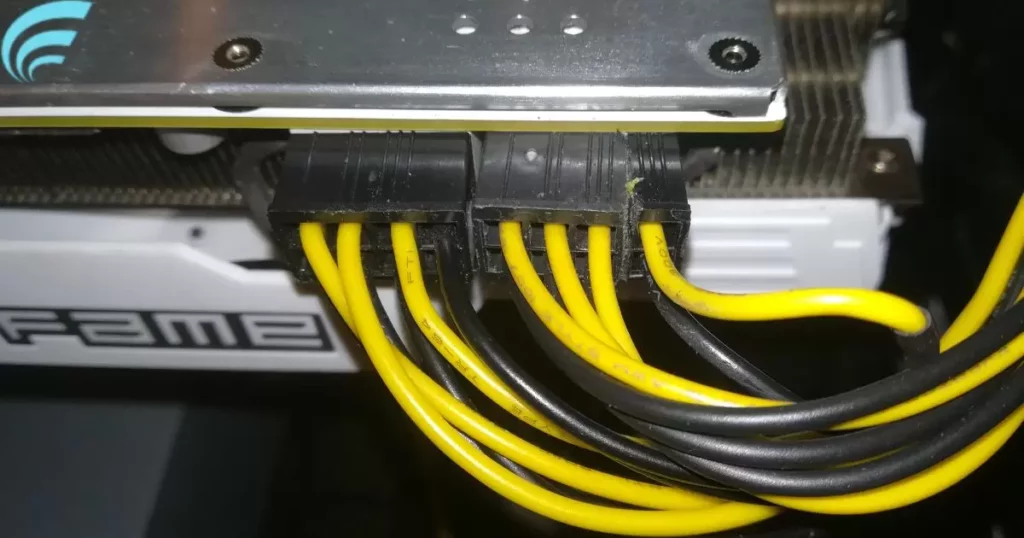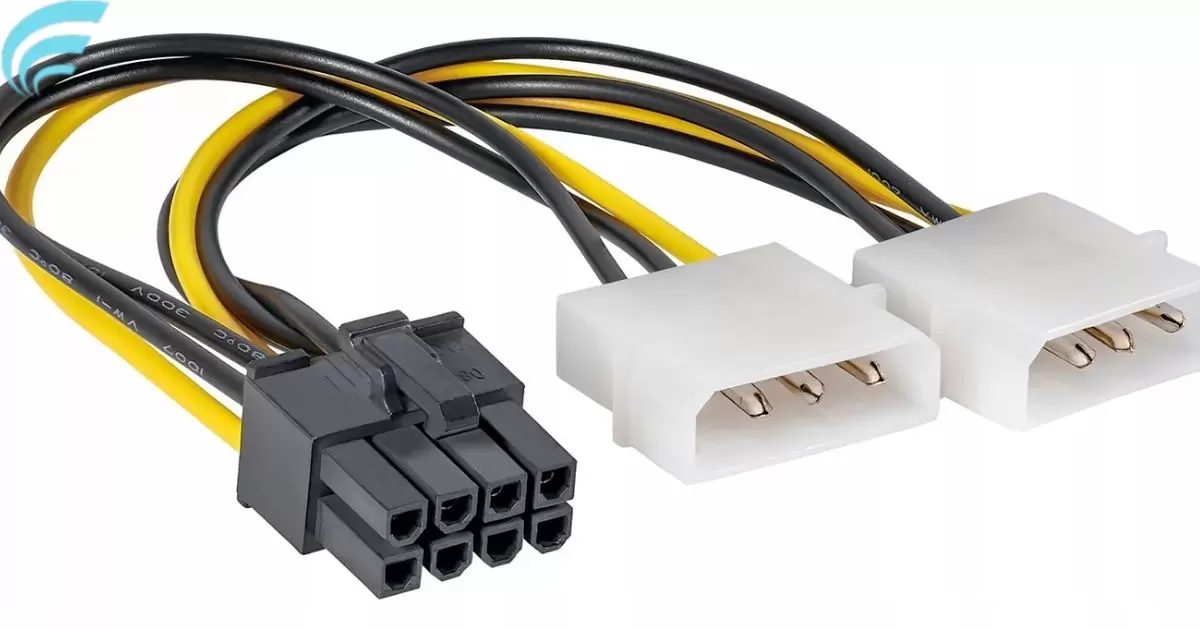If your graphics card needs 8 pins but your power supply only has 6, it might not work properly. The pins give power, and not having enough could make the card act weird or not work at all. It’s like trying to fill a big glass with water from a small bottle; it might not fit or work right. Always use the right number of pins for your graphics card to make it run smoothly.
Hey there! Ever wondered, Can I run an 8-pin GPU with a 6-pin connector? If you’re diving into the world of graphics cards, it’s a question worth exploring. Discover the answer and unlock the secrets to seamless gaming and smooth performance. Don’t miss out; let’s demystify this tech puzzle together.
Wondering if you can use a 6-pin connector for an 8-pin GPU? It’s like having a key that almost fits the lock. While it might physically connect, the GPU may not get enough power, leading to glitches or poor performance. To avoid issues, always match the GPU’s requirements with the right number of pins on your power supply.
Understanding GPU Power Requirements
Wondering about GPU power needs? Graphics cards often come with specific power requirements, typically indicated by the number of pins needed for connection. The common question that arises is, Can I run an 8-pin GPU with a 6-pin connector? Let’s delve into the intricacies of GPU power compatibility to ensure your hardware runs seamlessly.
When you see those little connectors on your graphics card, they’re not just there for show. They’re like the card’s lifeline, providing the necessary power to make it work efficiently. Understanding these requirements is key to avoiding potential issues and optimizing your GPU’s performance.
The Compatibility Question: 8-pin GPU and 6-pin Connector
Compatibility is crucial in the tech world. When faced with the query of whether an 8-pin GPU can run on a 6-pin connector, it’s essential to grasp the nuances. While physically fitting is one thing, ensuring the right power supply is another. Graphics cards are power-hungry beasts, and using an incompatible connector might result in less-than-ideal performance.
It’s akin to trying to charge your latest smartphone with an outdated charger; it might work, but you won’t get the optimal charging speed, and it could potentially harm your device. The same principle applies to GPUs. Let’s uncover the potential risks associated with using a 6-pin connector for an 8-pin GPU.
Potential Risks of Using a 6-pin Connector for an 8-pin GPU
Mismatching power connectors may seem like a quick fix, but it comes with its share of risks. The 8-pin GPU requires a specific amount of power to operate optimally. Using a 6-pin connector might mean the GPU doesn’t receive enough juice, leading to performance issues, system crashes, or, in extreme cases, damage to your hardware.
Imagine your car needing premium fuel, and you decide to fill it up with regular – it might run, but it won’t function at its best. Similar logic applies here. To better understand the impact on GPU performance, let’s explore how using an incorrect power connector can affect your gaming experience.
Exploring the Impact on GPU Performance

The performance of your graphics card is directly tied to the power it receives. Connecting an 8-pin GPU to a 6-pin connector introduces a bottleneck in power supply, hindering the card’s ability to operate at its full potential. This bottleneck can manifest as reduced frame rates, graphical glitches, or even system instability during resource-intensive tasks like gaming or graphic design.
To illustrate, it’s like having a powerful engine in your car but using a narrow and winding road; the engine’s potential, much like understanding What Is GPU Hotspot Temperature? is limited by the constraints of the road. Similarly, your GPU’s capabilities are restrained when not supplied with the required power. Now, let’s delve into why the right power connection is crucial for the overall health of your graphics card.
Why the Right Power Connection Matters for Your Graphics Card
Ensuring your graphics card gets the power it needs is paramount for its longevity and optimal performance. The right power connection ensures a stable and consistent flow of energy, preventing potential damage due to insufficient power or fluctuations. Think of it as providing the right fuel to keep your engine running smoothly.
Choosing a power supply that matches your GPU’s requirements is akin to selecting the correct fuel grade for your car. Neglecting this crucial aspect could result in diminished performance, overheating, or, in worst-case scenarios, permanent damage to your graphics card. Now, let’s navigate the process of choosing the correct power supply for your GPU.
Choosing the Correct Power Supply for Your GPU
Selecting the right power supply for your GPU involves understanding the power requirements of your graphics card and ensuring compatibility with your system. Power supply units (PSUs) come with various wattage ratings and connectors, and it’s crucial to match these specifications with your GPU’s needs.
Think of it as choosing the right-sized battery for your electronic device: too small, and it won’t last; too big, and it might cause problems. Similarly, a well-matched power supply ensures your GPU receives the necessary power without overloading or underpowering it. Let’s now address some common issues that users may encounter when attempting to run an 8-pin GPU on a 6-pin connector.
Common Issues When Running an 8-pin GPU on a 6-pin Connector

Attempting to run an 8-pin GPU on a 6-pin connector can lead to a range of issues. From random crashes during gaming sessions to graphical artifacts appearing on your screen, these problems can be frustrating and impact your overall computing experience.
It’s like fitting a square peg into a round hole; it might work for a while, but it’s not a sustainable solution. To avoid such headaches, it’s essential to follow best practices when powering your high-performance graphics card, ensuring a smooth and glitch-free gaming experience.
Best Practices for Powering Your High-Performance Graphics Card
To ensure your GPU operates at its best, adhere to best practices for power supply. Invest in a PSU that meets or exceeds your graphics card’s power requirements, providing ample headroom for future upgrades. Additionally, check that the PSU has the necessary connectors, including the correct number and type of pins.
Maintaining your vehicle with regular check-ups and using the right fuel will keep it running smoothly. Similarly, a well-maintained and adequately powered GPU contributes to a seamless gaming and computing experience. Now, let’s delve into a practical aspect of how to check and, if necessary, upgrade your power supply for optimal GPU compatibility.
How to Check and Upgrade Your Power Supply for GPU Compatibility
Before diving into the world of high-end graphics cards, it’s crucial to assess your current power supply’s capabilities. Check the wattage, available connectors, and compatibility with your GPU’s requirements. If your PSU falls short, it might be time for an upgrade.
Think of it as upgrading your car’s engine to accommodate more horsepower; the old engine might not support the demands of the new one. Similarly, upgrading your power supply ensures your system can provide the necessary power without compromising performance. Finally, let’s wrap up with a focus on ensuring a smooth gaming experience by matching pins for optimal GPU functionality.
Ensuring smooth gaming: Matching Pins for Optimal GPU Functionality
In the world of gaming, a smooth experience is non-negotiable. Matching the pins on your GPU with the right power connectors ensures a stable and uninterrupted gaming session. It’s like having the perfect controller for your favorite game; the right fit enhances your overall experience.
Picture it as trying to play your favorite game with a faulty controller; the experience becomes frustrating and less enjoyable. Similarly, ensuring the optimal functionality of your GPU by using the correct power connectors is a small but crucial step in maximizing your gaming pleasure. In conclusion, understanding and adhering to GPU power requirements is fundamental for a seamless and enjoyable computing experience.
FAQs
Is it safe to use a 6-pin connector for an 8-pin GPU?
Using a 6-pin connector may pose risks, potentially leading to performance issues or damage to your GPU.
What happens if I connect my 8-pin GPU to a 6-pin connector?
Mismatched connectors can result in reduced GPU performance, causing problems like frame rate drops and graphical glitches during tasks like gaming.
Can I temporarily use a 6-pin connector until I get the right one?
While it might physically fit, using an incorrect connector can cause short-term issues and is not recommended for prolonged use.
How do I check if my power supply supports my GPU’s requirements?
Review your power supply’s wattage, connectors, and compatibility with your GPU to ensure it meets the necessary specifications.
What’s the importance of matching GPU pins with the right connector?
Matching pins ensures a stable power supply, promoting optimal GPU functionality and contributing to a smooth computing or gaming experience.
Conclusion
In wrapping up our exploration into the question, Can I run an 8-pin GPU with a 6-pin connector? It becomes evident that, while it may seem like a quick fix, using an incompatible power connector poses significant risks. Attempting to run a high-power GPU on a lower-rated connector can lead to performance issues, potential hardware damage, and an overall unsatisfactory computing experience. Ensuring the right power connection is like providing the correct fuel to a high-performance engine; it’s essential for optimal functionality.
In the world of GPUs, precision matters. So, can you run an 8-pin GPU with a 6-pin connector? The short answer is that it’s not advisable for long-term use. To guarantee smooth and glitch-free performance, always match the GPU’s power requirements with the appropriate number of pins on your power supply. Think of it as the foundation for a stable and enjoyable computing or gaming experience; ensuring your hardware gets the right power ensures it can deliver its best.











